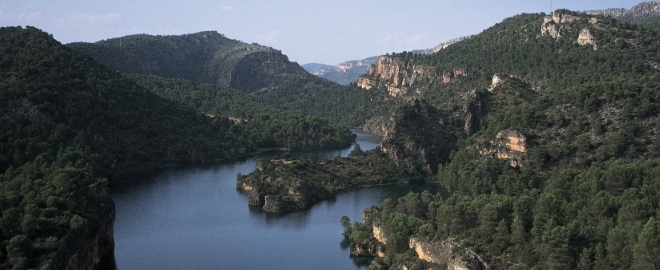 Many still don’t know it, but the lands of Guadalajara, one of the provinces of Castilla-La Mancha, hide a multitude of secrets that you can discover if you want. Secrets that keep a historical wealth of incalculable value. Riches that are hidden in what comes to be called La Alcarria.
Many still don’t know it, but the lands of Guadalajara, one of the provinces of Castilla-La Mancha, hide a multitude of secrets that you can discover if you want. Secrets that keep a historical wealth of incalculable value. Riches that are hidden in what comes to be called La Alcarria.
You may not believe it, but years ago Guadalajara was one of the most important places in Spain. Archaeological remains from the stone age are hidden under the soil of this province, such as those you can discover in the Cueva de los Casares, located in the Alto Tajo Natural Park in the southeast of the province, sharing land with Cuenca. But we can also find bits of Visigothic history like the ones kept with care by themunicipality of Zorita de los Canes. There you can visit what was once Recópolis, a Visigothic city founded by Leovigildo in the year 578, located at the foot of the Tagus River.
And a journey through the history of the passage of Muslims through the lands of La Alcarria could not be missing. You can take this walk through the municipality of Campillo de Dueñas where the castle of Zafra stands on a large rock in the Vega de Zafra.
Or by the municipality of Molina de Aragón. Its fields are the base of one of the largest castles in the province, the fortress of Molina de los Caballeros, built around the 10th century. A place that gave shelter to the kings of this taifa. They say that the Cid stayed there when he was exiled from Castile. And it is that, according to legend, the great Rodrigo Díaz de Vivar also offered his services to taifa kings, despite becoming the ‘Christian Hero of La Reconquista’. And another Rodrigo Díaz de Vivar, Mendoza, Marquis of Zenete and Count of El Cid in the 15th century lived in another of the must-see castles, the one that stands in the municipality of Jadraque.
Land of the Princess of Eboli
- In 1492 this Reconquest was concluded with the capture of Granada, but La Alcarria then had a few years of splendor behind it… The foundations of this lucid stage were laid by the Mendoza family, protagonists in the 14th century. And to see this little piece of history with your own eyes, you have no choice but to visit the municipality of Pastrana.
- In this article we recommend that to start and plan your trip through La Alcarria, you lay the foundations at this point. Because if you want to explore these lands and soak up all its history, you will need more than one day, so one of the most magical places to stay and spend the night is in this curious town. A town through which centuries have barely passed…
- Pastrana was founded in the 13th century, precisely, according to what they say, as a repopulation village after the definitive expulsion of the Arabs… After some trick or other, King Carlos I in 1541, he sold the town of Pastrana to Doña Ana de la Cerda, the Countess of Mélito and widow of Diego Hurtado de Mendoza y Lemos. It is this, the one that she begins to build one of the biggest tourist attractions of this town: The Ducal Palace. A palace that in 1569 came into the hands of his granddaughter, daughter of his son Diego Hurtado de Mendoza y de la Cerda and Catalina de Silva: the famous Doña Ana de Mendoza y de la Cerda, better known as the Princess of Éboli after her marriage with Ruy Gómez de Silva in 1553. Later the couple obtained from King Felipe II the title of Dukes of Pastrana.
- And it is with these first Dukes when the period of maximum splendor arrives in this area of La Alcarria, since they are in charge of carrying out great works that you can still see standing today with your own eyes. For example, in 1569 the Duchess sent for Santa Teresa de Jesús to build a convent of Discalced Carmelites.
- But the story of the Princess of Éboli ends badly… By order of the King, she is locked up in his Ducal Palace and from there she would not leave until the day of her death in 1592. Her remains rest in the Collegiate Church of this magical town. Pastrana preserves its medieval layout and that richness that made it great during the Golden Age.
